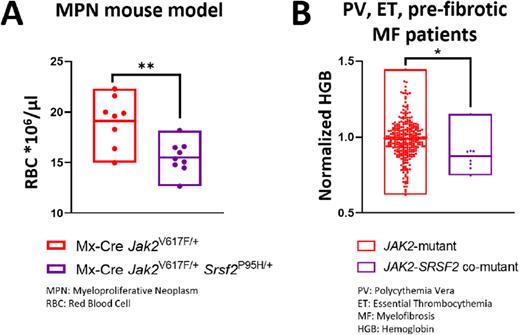Abstract
Polycythemia vera (PV) is characterized by marked erythrocytosis, most commonly managed with therapeutic phlebotomy or cytoreduction. Conversely, anemia is often a feature of myelofibrosis (MF), where it is associated with poor prognosis. The transition from PV to MF is associated with the acquisition of additional somatic mutations in several gene classes, including RNA splicing factors.
Since mutations in the RNA splicing factor SRSF2 are associated with anemia in myelodysplastic syndrome (MDS), we set out to investigate how SRSF2 mutations impact erythropoiesis in multiple contexts, including at steady-state, stress-induced, and in the setting of MPN.
We first studied the consequences of Srsf2P95H mutations on steady-state erythropoiesis. Primary Mx-Cre Srsf2P95H/+ mice had a reduced red blood cell count (RBC, P<0.001), increased mean corpuscular volume (MCV, P<0.001), and reduced percentage of early erythroid progenitors (pre-CFU-E) in the bone marrow (BM, P=0.04) compared to Mx-Cre mice, consistent with published data (Kim et al., 2015). Moreover, Srsf2P95H/+ mice had a reduced percentage of proliferating pre-CFU-E cells (P=0.03).
We next studied the impact of Srsf2P95H mutations on stress-induced erythropoiesis, using a phenylhydrazine (PHZ)-induced hemolysis model. We treated primary Mx-Cre and Mx-Cre Srsf2P95H/+ mice with 30 mg/kg PHZ on days 0 and 1. As expected, RBCs were reduced by ~40% confirming effective hemolysis on day 3. On day 6, PHZ-treated control mice had higher reticulocyte counts compared to Srsf2P95H/+ mice (P=0.005), while the inverse was true on day 9 (P=0.03). Consistently, the frequency of BM pre-CFU-E cells was increased in Srsf2P95H/+ mice vs controls on day 9 (P=0.04). In aggregate, these data indicate that Srsf2P95H/+ mice have a slower recovery to PHZ-induced anemia. Moreover, late erythroid progenitors (CFU-E) were reduced in PHZ-treated Mx-Cre Srsf2P95H/+ vs control mice on day 4 post PHZ (P=0.04). Also, the percentage of BM erythroblasts was 24% reduced (P=0.04), mostly due to a reduction in stage III erythroblasts, and spleen weights were 19% lower in Srsf2P95H/+ vs controls on day 4 (P=0.01). These data suggest defects at the stage III erythroblast, and erythroid progenitor levels due to Srsf2P95H.
Our next goal was to understand how Srsf2 mutations affect Jak2-mutant MPN. In line with the data outlined above, primary Mx-Cre Jak2V617F/+Srsf2P95H/+ mice had lower RBC (Fig. A, P=0.002) and higher MCV values (P<0.001) compared to Mx-Cre Jak2V617F/+ mice. These data were recapitulated in a BM transplant model confirming that impaired erythropoiesis is cell intrinsic. Moreover, pre-CFU-E and CFU-E levels were lower in the BM and spleen of Jak2V617F/+Srsf2P95H/+ vs Jak2V617F/+ transplant mice ~30 weeks post pIpC (BM P=0.003 and 0.01, spleen 0.02 and 0.005, respectively). Compared to wild-type mice, mice transplanted with Jak2V617F/+ cells had an elevated fraction of stage II and reduced fraction of stage III erythroblasts, which was partially normalized in Jak2V617F/+Srsf2P95H/+ mice. Finally, spleen weights were >50% lower in Jak2V617F/+Srsf2P95H/+ vs Jak2V617F/+ transplant mice (P<0.001). These data show that Srsf2P95H diminishes Jak2V617F-driven erythropoiesis at the progenitor level and at erythroblast stages II and III.
Finally, we interrogated a clinical dataset of 301 JAK2-mutant MPN patients (PV n=157; ET n=129; pre-fibrotic MF n=15) with comprehensive molecular profiling and laboratory results. Eight patients carried both, an SRSF2 mutation (VAF>5%) and a JAK2 mutation. JAK2-SRSF2 co-mutant patients had significantly reduced hemoglobin values compared to JAK2-mutant patients (Fig. B, P=0.01), in agreement with our mouse models.
Together, our study shows that Srsf2P95H impairs erythropoiesis in the BM and spleen at multiple differentiation levels. These data contribute to a better understanding of phenotypic differences between JAK2-mutant MPN patients. Since several genes implicated in erythropoiesis and heme metabolism have been shown to be misspliced in SRSF2-mutant MDS, we are currently analyzing RNA-sequencing data from wild-type and Srsf2P95H/+ CFU-E cells, with the expectation that these data will provide insights into the underlying mechanisms driving anemia. These data may ultimately help identify novel therapeutic targets to alleviate anemia in SRSF2-mutant MPN and MDS, which is an area of unmet clinical need.
Disclosures
Stahl:Novartis: Other: Advisory Board; Boston Consulting: Consultancy; Curis Oncology: Consultancy. Luskin:Abbvie: Research Funding; Pfizer: Honoraria; Novartis: Research Funding. Graubert:H3 Biomedicine: Honoraria; Juno Therapeutics: Honoraria; Janssen: Research Funding. Mullally:Relay Therapeutics: Research Funding; Aclaris Therapeutics: Consultancy; Cellarity: Consultancy; Constellation: Membership on an entity's Board of Directors or advisory committees; PharmaEssentia: Membership on an entity's Board of Directors or advisory committees; Janssen: Research Funding; Actuate Therapeutics: Research Funding; Morphic Therapeutics: Consultancy; Biomarin Pharmaceuticals: Consultancy.
Author notes
Asterisk with author names denotes non-ASH members.


This feature is available to Subscribers Only
Sign In or Create an Account Close Modal